“Global Warehouse Automation Market to reach a market value of 66.6 Billion by 2031 growing at a CAGR of 18%”
The Global Warehouse Automation Market size is expected to reach $66.6 billion by 2031, rising at a market growth of 18% CAGR during the forecast period.
Many healthcare products, including vaccines, biologics, and certain pharmaceuticals, require controlled temperature environments for storage. Automated warehouse systems with temperature monitoring and control capabilities ensure these sensitive products are stored optimally, preventing spoilage and maintaining product efficacy. Thus, the healthcare segment procured 23% revenue share in the warehouse automation market in 2023.
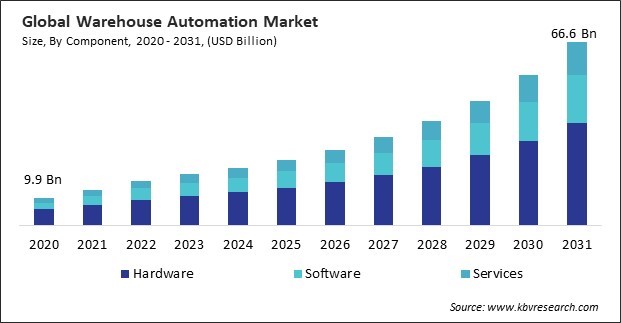
The major strategies followed by the market participants are Product Launches as the key developmental strategy to keep pace with the changing demands of end users. For instance, In September, 2021, Honeywell International, Inc. released Smart Flexible Depalletizer. Powered by machine learning and advanced perception technologies, automates pallet unloading to reduce workplace injuries and boost productivity. The robot adapts to various pallets, learns from each operation, and can integrate with autonomous mobile robots, making it a valuable solution for labor-strapped warehouses.
Based on the Analysis presented in the KBV Cardinal matrix; Honeywell International, Inc. and ABB Group are the forerunners in the Warehouse Automation Market. Companies such as FANUC Corporation, Murata Machinery, Ltd., KION GROUP AG are some of the key innovators in Warehouse Automation Market. In December, 2023, FANUC Corporation unveiled the M-710iD/50M robot, an updated model in its M-710i series. It features a 50kg payload, enhanced rigidity, and a curved arm for improved accessibility. With a 2,606mm reach and IP67 rating, it offers precision, durability, and ease of maintenance for various applications.
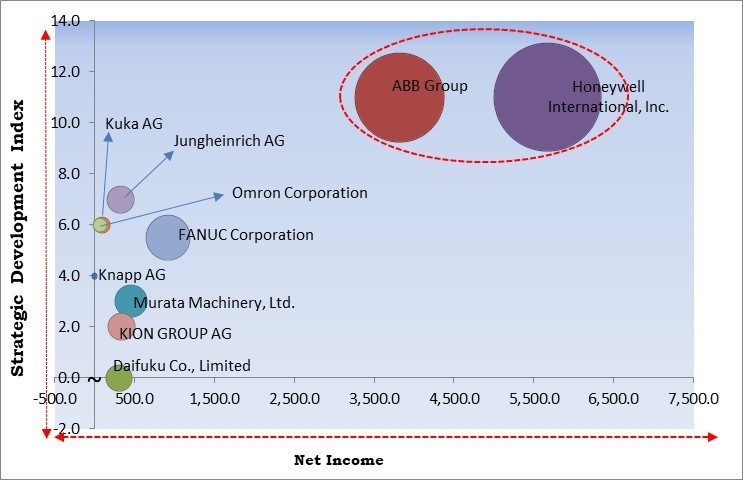
Warehouse automation technologies, such as automated storage and retrieval systems (AS/RS), dynamic shelving, and robotic systems, enable more effective use of available space. These systems can optimize storage density by employing vertical space, reducing aisle widths, and automating inventory retrieval processes. As businesses seek to make the most of their warehouse space, the demand for automation solutions that enhance space utilization is increasing.
Additionally, technologies like automated picking systems and conveyor belts operate around the clock, helping businesses meet demand without the constraints of workforce shortages. In conclusion, escalating labor costs and workforce shortages propel the market's growth.
The process of tailoring automation systems to meet specific needs can be complex and resource intensive. The challenges associated with customization can lead to increased costs and extended implementation timelines, making businesses hesitant to adopt such technologies. Thus, the high complexity of advanced automation systems is impeding the market's growth.
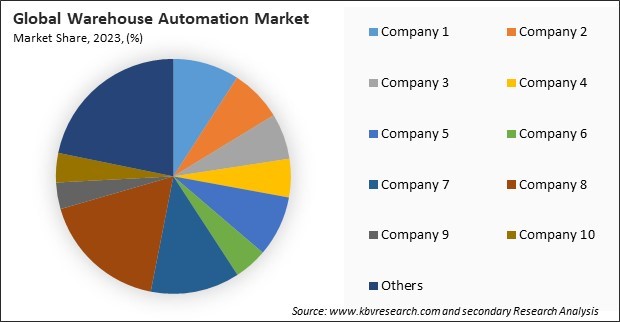
The leading players in the market are competing with diverse innovative offerings to remain competitive in the market. The below illustration shows the percentage of revenue shared by some of the leading companies in the market. The leading players of the market are adopting various strategies in order to cater demand coming from the different industries. The key developmental strategies in the market are Product Launches and Product Expansions.
The services segment is further subdivided into installation & integration, consulting, training & education, maintenance & support, and analytics & reporting tools. In 2023, the installation & integration segment acquired 41% revenue share in the market. Installation and integration services aim to minimize downtime while deploying new systems.
On the basis of level, the market is segmented into intermediate automation, basic automation, advanced automation, and autonomous warehouses. The intermediate automation segment recorded 38% revenue share in the market in 2023. In 2023, the advanced automation segment attained 28% revenue share in the market.
By application, the market is divided into retail & e-commerce, automotive, aerospace & defense, healthcare, electronics & semiconductors, and other applications. In 2023, the retail & e-commerce segment registered 28% revenue share in the market.
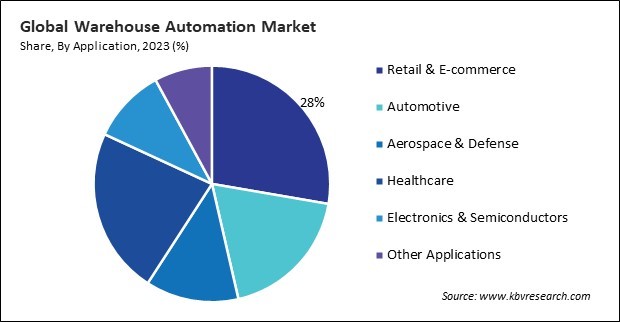
Based on component, the market is divided into hardware, software, and services. In 2023, the hardware segment garnered 57% revenue share in the market. Hardware components form the backbone of warehouse automation. These physical systems are essential for executing automated tasks such as sorting, picking, packing, and transporting goods.
The hardware segment is further subdivided into autonomous robots (AGV, AMR), automated sorting systems, automated storage & retrieval systems (AS/RS), de-palletizing/palletizing systems, conveyor systems, and automatic identification & data collection (AIDC) In 2023, the autonomous robots (AGV, AMR) segment acquired 28% revenue share in the market.
The software segment is further subdivided into warehouse management system (WMS), warehouse execution systems (WES), and labor management systems (LMS). In 2023, the warehouse management system (WMS) segment procured 50% revenue share in the market. WMS software offers real-time tracking of inventory levels, locations, and movements.
Free Valuable Insights: Global Warehouse Automation Market size to reach USD 66.6 Billion by 2031
Region-wise, the market is analyzed across North America, Europe, Asia Pacific, and LAMEA. The North America segment garnered 44% revenue share in the market in 2023. This dominance is due to the region's robust technological infrastructure, significant investment in quantum research, and the leadership of major technology corporations in the development of this AI.
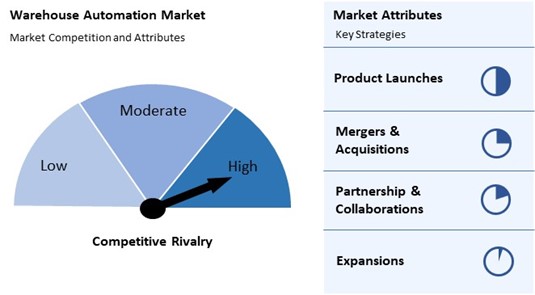
The competition in the market is intense, with tech giants and startups vying for breakthroughs in quantum computing applications for AI. Companies focus on developing scalable quantum algorithms and hardware. Strategic collaborations, investments, and advancements in quantum machine learning are accelerating the competitive dynamics in this emerging field.
| Report Attribute | Details |
|---|---|
| Market size value in 2023 | USD 18.5 Billion |
| Market size forecast in 2031 | USD 66.6 Billion |
| Base Year | 2023 |
| Historical Period | 2020 to 2022 |
| Forecast Period | 2024 to 2031 |
| Revenue Growth Rate | CAGR of 18% from 2024 to 2031 |
| Number of Pages | 439 |
| Tables | 704 |
| Report coverage | Market Trends, Revenue Estimation and Forecast, Segmentation Analysis, Regional and Country Breakdown, Competitive Landscape, Market Share Analysis, Porter’s 5 Forces Analysis, Company Profiling, Companies Strategic Developments, SWOT Analysis, Winning Imperatives |
| Segments covered | Component, Level, Application, Region |
| Country scope |
|
| Companies Included | Honeywell International, Inc., Murata Machinery, Ltd., Knapp AG, ABB Group, FANUC Corporation, Kuka AG (Midea Group Co., Ltd.), Jungheinrich AG, KION GROUP AG, Daifuku Co., Limited and Omron Corporation |
By Component
By Level
By Application
By Geography
This Market size is expected to reach $66.6 billion by 2031.
Escalating labor costs and workforce shortages are driving the Market in coming years, however, High complexity of advanced automation systems restraints the growth of the Market.
Honeywell International, Inc., Murata Machinery, Ltd., Knapp AG, ABB Group, FANUC Corporation, Kuka AG (Midea Group Co., Ltd.), Jungheinrich AG, KION GROUP AG, Daifuku Co., Limited and Omron Corporation
The expected CAGR of this Market is 18% from 2024 to 2031.
The Intermediate Automation segment is leading the Market by Level in 2023, achieving a market value of $24.1 billion by 2031.
The North America region dominated the Market by Region in 2023, and would continue to be a dominant market till 2031; thereby, achieving a market value of $23,087.6 million by 2031.
Our team of dedicated experts can provide you with attractive expansion opportunities for your business.

 Drivers
Drivers
 Restraints
Restraints
 Opportunities
Opportunities
 Challenges
Challenges
